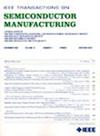Optimal Design of Wet Etching Bath for 3-D Flash Memories Using Multi-Objective Bayesian Optimization
IF 2.3
3区 工程技术
Q2 ENGINEERING, ELECTRICAL & ELECTRONIC
引用次数: 0
Abstract
Recently, the complexity of semiconductor manufacturing processes has increased, resulting in a growing need for high-precision optimization of device structures. For example, in batch-type wet etching devices, the flow of chemical liquids in the process bath can vary depending on the device structure, which causes variations in the etching state of the wafer. This issue is addressed using a feedback mechanism that adjusts the device structure iteratively based on the results of an etching experiment, thereby achieving more uniform etching conditions. However, this approach requires a large number of trial experiments. In the fabrication process of 3D flash memory devices, the formation of word lines in the silicon substrate requires precise control of the silicon concentration in the etching solution. However, this concentration can fluctuate due to the dissolution of the SiN film during the etching process, which can cause various problems. Thus, this study proposes an innovative multi-objective Bayesian optimization method that is informed by image and physical quantity data from fluid dynamics simulations to derive optimal wet etching bath design parameters. The proposed method was validated through simulation experiments, and the simulation results were used to identify the best possible wet etching bath designs.基于多目标贝叶斯优化的三维闪存湿蚀刻槽优化设计
近年来,半导体制造工艺的复杂性不断增加,导致对器件结构高精度优化的需求日益增长。例如,在间歇式湿式蚀刻装置中,工艺槽中化学液体的流动可以根据器件结构而变化,从而导致晶圆的蚀刻状态发生变化。利用反馈机制,根据蚀刻实验结果迭代调整器件结构,从而实现更均匀的蚀刻条件,解决了这个问题。然而,这种方法需要大量的试验。在3D闪存器件的制造过程中,硅衬底上字线的形成需要精确控制蚀刻液中硅的浓度。然而,由于在蚀刻过程中SiN薄膜的溶解,该浓度可能会波动,从而导致各种问题。因此,本研究提出了一种创新的多目标贝叶斯优化方法,该方法通过流体动力学模拟的图像和物理量数据来获得最佳湿蚀刻槽设计参数。通过仿真实验验证了该方法的有效性,并利用仿真结果确定了最佳的湿法蚀刻槽设计方案。
本文章由计算机程序翻译,如有差异,请以英文原文为准。
求助全文
约1分钟内获得全文
求助全文
来源期刊

IEEE Transactions on Semiconductor Manufacturing
工程技术-工程:电子与电气
CiteScore
5.20
自引率
11.10%
发文量
101
审稿时长
3.3 months
期刊介绍:
The IEEE Transactions on Semiconductor Manufacturing addresses the challenging problems of manufacturing complex microelectronic components, especially very large scale integrated circuits (VLSI). Manufacturing these products requires precision micropatterning, precise control of materials properties, ultraclean work environments, and complex interactions of chemical, physical, electrical and mechanical processes.
 求助内容:
求助内容: 应助结果提醒方式:
应助结果提醒方式:


